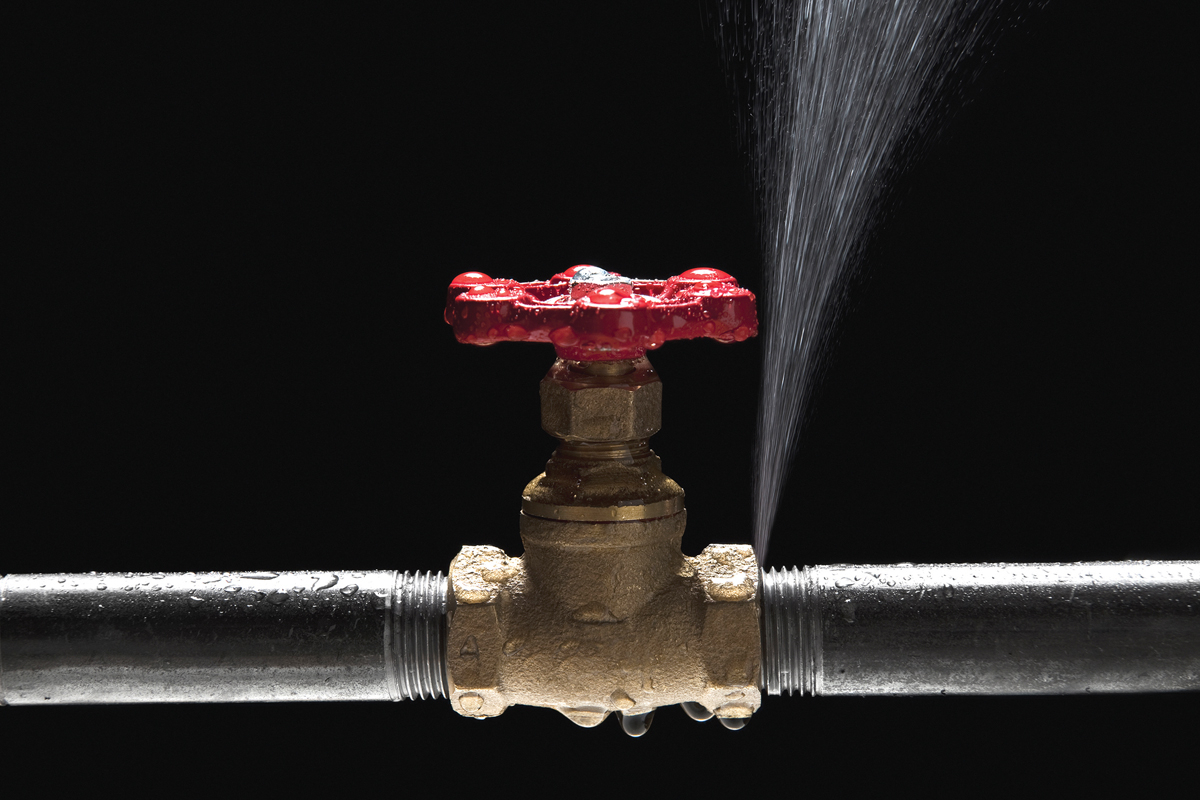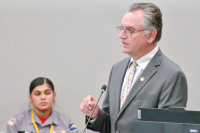Coming down the pipe: EPA mandate could soak local utility customers

A recent update to the U.S. Environmental Protection Agency’s Lead and Copper Rule directs nearly all of the nation’s water systems to conduct an inventory of service lines by October, checking for the presence of lead pipes due to their well-established health risks.
The inventory is the first step in the Biden-Harris administration’s plan to get rid of an EPA-estimated 9.2 million lead pipes across the country within 10 years, including nearly 370,000 in North Carolina’s 6,000 regulated water systems.
President Joe Biden’s Bipartisan Infrastructure Law will provide $15 billion to communities specifically for lead service line inventory and replacement through the Drinking Water State Revolving Fund, but the state funding stream is competitive, complicated and may not fully fund the work.
The cost of the inventory, which for some systems will be a mammoth undertaking requiring time, money and eventually digging up water connections on private property, could end up soaking local taxpayers.
Durable yet malleable and relatively easy to work with, lead has been used as a building material for thousands of years, from Europe to Turkey to China. Historically, glass, gutters, paint, roofing and pipes all utilized the dense heavy metal to improve quality and resist corrosion.
Although it is relatively benign if left undisturbed in its natural state, once it’s been worked, small particles can begin to spread throughout the environment and then enter living organisms, not so much through the skin as through aspiration or ingestion.
Related Items
The deleterious effects of lead were first noted by the ancient Greeks and Romans, who used the versatile metal for everything from aqueduct linings to bowls, forks and spoons. The science, however, wasn’t there even through the Middle Ages, when lead use became much more extensive.
Later, Benjamin Franklin recognized adverse health consequences both for painters as well as printing press operators who routinely handled lead typesets. Charles Dickens chronicled the use of lead during the Industrial Revolution and the ghastly toll prolonged exposure took on workers — especially poor urban women, who had trouble bearing children and experienced high infant mortality rates when they did.
It wasn’t until the early 1900s that a modern understanding of lead and its health risks became more widespread. Australia banned its use in paint in 1914, just before the American automobile industry began to learn about the benefits of adding lead-based chemicals to gasoline.
Workers at the DuPont Deep Water Works facility in New Jersey, where the tetraethyl lead fuel additive was synthesized, quickly began experiencing terrifying symptoms after working with the additive.
Dozens died. Some may have become “ violently insane.”
All had worked in a building later named “The House of Butterflies,” because hallucinating workers were seen compulsively brushing imaginary insects from their bodies.
Acute lead poisoning can be survivable, especially for adults, but it wasn’t until the 1940s that connections between lead poisoning and lasting damage became apparent — most notably in young children and their developing brains.
Leaded gasoline for automobiles was banned in the United States beginning with the 1975 model year and was completely phased out for on-road use in 1996. Lead paint was outlawed for residential applications in the United States in 1978, although some U.S. cities and states had banned it years earlier.
Lead pipes, however, remained acceptable for use until amendments to the Safe Water Drinking Act of 1974 were passed by Congress in 1986 — but they didn’t eliminate the use of lead in drinking water systems altogether. Solders and flux could still contain small amounts of lead, while pipes and fittings could have no more than 8% lead.
In 1991, the Environmental Protection Agency issued its first Lead and Copper Rule to reduce concentrations in drinking water. Copper piping, while less toxic than lead, can often be found in conjunction with lead solder.
Almost 20 years later, in 2011, the Reduction of Lead in Drinking Water Act was passed and enacted by Congress, tightening the allowable levels of lead in pipes.
Then came Flint, which changed everything.
In 2014, the Michigan town of nearly 100,000 switched water sources, which ultimately resulted in lead leaching from old pipes. Michigan’s governor as well as President Barack Obama each declared states of emergency. As many as 12,000 children were exposed to lead in their drinking water, 12 people died from an outbreak of Legionnaires’ Disease, 79 lawsuits were filed, 15 people were indicted and one person was sentenced to probation, community service and a fine for willful neglect of duty. Victims received a $641 million settlement, and more than $400 million in state and federal funding poured into the town for lead service line replacement.
As a response, the EPA worked on tightening loopholes in the RLDWA in 2021.
The EPA-mandated inventory, which was first formally rolled out to local governments in December 2022, must be completed by Oct. 16.
In Waynesville, that task falls to Public Services Director Jeff Stines, who’s been with the town for 28 years. Stines thinks his town of 10,000 people has around 8,000 municipal water service connections.
“It’s a big task,” said Stines. “I mean, it’s doable. It’s just something we have to do. We just deal with it, get it done and move on.”
Each service line under 2 inches in diameter must be identified by location and then categorized in one of four ways — lead, galvanized requiring replacement, non-lead or other. Galvanized lines that are downstream from lead lines or lines of unknown composition are to be considered lead service lines and need to be replaced because they can contribute to lead showing up in water at the customer’s tap.
Water systems must use any available information at hand when conducting the inventory, including construction and plumbing codes, historical records, permits, surveys or system maps, however the recommended methods are visual inspection, water sampling or excavation.
The inventory will concentrate on service lines installed before lead pipes were banned in the late 1980s.
When each service line is identified, the information has to be entered into a 32-column spreadsheet template and submitted to the Public Water Section of the state’s Department of Environmental Quality.
Waynesville, which has more than 140 miles of water lines, plans to engage a third-party contractor to help with the initial survey. Stines said the contractor will use data in the form of property tax cards and other records to conduct predictive modeling and identify locations of concern to help automate spreadsheet population.
Once the spreadsheet is formally accepted by DEQ, it must be made available to the public and updated every three years, but that acceptance also kicks off a verification and replacement process to be completed over a 10-year period, per a pending update to the Lead and Copper Rule.

Public works employees will use a spreadsheet to catalog pipe locations and materials. File photo
Like many small municipalities, Waynesville has a tight budget and limited number of public works employees available to complete the task. Stines supervises around 90, not all of them specifically involved in field work.
In most every case, verification of pipes of unknown composition will involve those crews attempting to enter private property and begin digging on the customer side of the water meter.
Waynesville Town Manager Rob Hites, who has worked in municipal administration for decades, put the task in perspective; Hites said the town’s water crews are currently tied up with leaks, an inevitability of winter in the mountains. Once the leaks are fixed and winter turns to spring, those crews will go back to addressing a state mandate to correct inflow and infiltration in the system while simultaneously working to comply with the mandate.
“We’d have to buy vehicles, have to buy testing equipment, hire the employees, I mean, you could look at $150 to $200 per household,” Hites said. “Some of our meters are two to three feet deep, so it’s not just a matter of sticking the shovel in the ground and hitting a pipe. They may be digging for a while to get to that pipe.”
Stines agrees it will take a lot of extra resources to complete the task.
“We’re going to have to dedicate a crew or crews to do this, along with other maintenance,” he said. “I mean, you’re talking at least four, maybe even eight people working on this verification process. There’ll be quite a bit [of digging] and one of the issues that I know not only Waynesville but other municipalities face is gaining access to private property.”
The EPA requires water systems to document at least four attempts to contact property owners about access to their service lines.
“Locally, we have to look at it two ways,” Hites said. “How are we going to staff it, and how are we going to afford it?”
Another kink in the process has to do with how the town is allowed to pay for the inventory.
In North Carolina, municipal enterprise funds, like water and sewer funds, must be self-sufficient. Monies from other funds, like the general fund, can’t usually be intermingled with enterprise revenues that rely on fund balance for emergencies.
Waynesville’s water fund operates on an annual budget of around $3.9 million. Fund balance may not be enough to cover the full cost of the inventory.
Of course, Waynesville isn’t the only water system affected by the nationwide mandate. Systems large and small from coast to coast all face unique challenges in staffing and funding.
“We serve around 1.1 million people, and we have to the tune of about 330,000 service lines and connections around our region,” said Veronica Horvath, senior public information specialist with Charlotte Water, which also operates in Mecklenburg County. “We are very large utility.”
Like in Waynesville, Charlotte Water will use predictive modeling to narrow the focus of its war on lead pipes, which Horvath said has been an ongoing effort for decades. Over the past year or so, crews have been conducting test digs to verify a 95% confidence level in the predictive models.
Charlotte is the 15th-largest municipality in the country by population and grew rapidly just after the turn of the 21st century, so many service lines were installed well after the lead ban in the late 1980s. Still, Horvath doesn’t know exactly what the inventory and verification/replacement process will cost Charlotte Water and its customers.
“It’s not going to be cheap,” she said.
Asheville has roughly 60,000 connections, which translates to well over 100,000 customers, says Asheville Water Resources Department Compliance Manager Brenna Cook, who told The Smoky Mountain News on Jan. 22 that they’re “slowly but surely” making progress on their inventory and replacement mandate.
To help cut down on the final scope of the inventory, workers have been incorporating the mandate into any calls for service they receive, classifying service lines whenever they encounter them.
They’re also encouraging customers to complete a survey, self-identifying their service lines. The completed surveys must include a picture, but the city needs at least one more piece of additional evidence to verify the pipe’s composition to the EPA’s satisfaction.
Clay Chandler, Asheville’s Water Resources Communications Specialist, said the town has already embarked on a voluntary effort in Shiloh, a historically disadvantaged community of about 1,200 households, to expedite the inventory and replacement process.
Franklin’s Town Manager, Amie Owens, said she’s had two employees chipping away at it eight hours a week, for months.
“The project is progressing well because we are actually doing a few things at one time. Not only are we meeting standards for the lead and copper inventory, but also leak detection on the system as a whole and utilizing GPS to precisely locate our meters for upload to our GIS system,” Owens said. “So it’s been a very beneficial exercise for us on multiple fronts. It’s our hope to have everything finished for submittal and review not later than the first week in September.”
In Haywood County, the Lake Junaluska Conference and Retreat Center is a small unincorporated community founded in the early 1900s. Today, there are about 3,200 residents.
“Lake J,” as it’s called, isn’t a municipality but does operate its own water system and is likewise subject to the EPA mandate.
Executive Director Ken Howle said that there are 820 water customers at Lake J, and that his public works people have already been working on the inventory. To streamline the process somewhat, a customer survey like Asheville’s will also be distributed.
“We are almost 50% through the inventory and are absorbing the cost of the inventory in our operating budget,” Howle said. “We will not know the estimated cost of repairs or replacement until after the inventory.”
Loans from the state are available, but they’re not guaranteed and they’re not free.
The DWSRF is a federal-state partnership. Congress appropriates money to the EPA, which awards the money to states as grants to capitalize a revolving loan fund, so long as the state agrees to provide a 20% match. The fiscal year 2023 appropriation to North Carolina was almost $180 million.
States then use the funds to provide zero-interest loans with extended repayment terms to community water systems for long-term infrastructure projects, but states can also designate a percentage of the funds for set-asides, which provide flexibility and the ability to fund technical assistance and training activities.
The North Carolina Department of Environmental Quality has since mid-July 2023 accepted competitive applications for funding lead-related projects through loans and continues to accept applications on an ongoing basis with upcoming deadlines in March, June and August.
Eligible projects fall under two basic categories — find and replace, or inventory only.
Find-and-replace projects are eligible for up to $2 million per application round if no more than $1 million is needed for inventory. Inventory-only projects are eligible for up to $1 million per round.
In September 2023, the 44 water systems that made $17.3 million in funding requests specifically for inventory-only projects were awarded a total of $16.6 million in loans by the State Water Infrastructure Authority (SWIA).
Of that, $9.9 million was designated for principal forgiveness, leaving those 44 systems to repay the remaining $6.7 million balance on their loans — as little as $3,803 for the Town of Princeton to as much as $600,000 for Sanford and several other systems.
Some of the systems that applied for inventory-only funding received no principal forgiveness whatsoever. Lenoir and Fuquay-Varina, for example, will have to repay their respective $500,000 loans entirely.
Others, like tiny Pittsboro, were left with nothing to repay at all.
Asheville asked for and received just under $2 million in loans solely for its Shiloh find-and-replace project, with nearly $1.4 million of that forgiven. Cook said she expects the town will make several more loan applications and despite its relatively large staff will have to contract out for some or all of the remaining work.
In December 2023, SWIA made another round of $13.1 million in awards to 18 applicants, 16 of them specifically for inventory-only projects.
More than half of the $9.1 million in principal for inventory-only projects was forgiven, but a small town like Burnsville — even smaller than Pittsboro — will still have to repay $234,000 of its $360,000 loan.
Notably, six of the awards were to DEQ-designated “distressed” communities like Waynesville. Those communities on average saw 90% principal forgiveness.
Hites said he’s got the town’s new grants administrator looking into the loans, but unless and until the loans are awarded, the town will have to come out of pocket. After the loans are awarded, they still may not cover the full cost of the EPA mandate.
“If it looks like we have to spend $150 or $200 per household to pay for trucks and testing equipment and software and manpower,” Hites said, “then we may have to look at a [water] rate increase at least to pay for this particular program and then we back it off once the program is over.”













